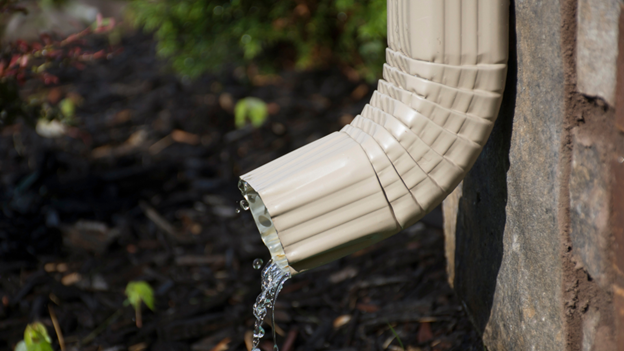Downspouts play a crucial role in protecting your home by channeling water safely away from your foundation, siding, and landscaping. While gutters often get most of the attention, downspouts are equally important — and without them, even the cleanest gutters can lead to costly water damage. The good news is that downspouts are relatively simple to care for, and a few seasonal checks can extend their lifespan significantly.
Here’s a season-by-season guide to keeping your downspouts in top condition year after year.
Spring: Clear Away Winter’s Leftovers
After a long winter, your downspouts may be clogged with leaves, sticks, and other debris left behind by storms. Snow and ice can also cause hidden cracks or bends.
Key steps for spring care:
- Flush the system: Run water from a hose through each downspout to ensure proper flow. Any sluggish drainage indicates a blockage that needs clearing.
- Check for cracks: Look closely for small splits caused by freezing and thawing cycles. These can worsen as the weather warms.
- Inspect connections: Winter winds and ice buildup sometimes loosen brackets and joints. Tighten or replace hardware as needed.
- Assess foundation drainage: Make sure extensions or splash blocks are still diverting water far enough away from your home.
Spring cleaning ensures your downspouts are ready to handle heavy seasonal rains without backing up.
Summer: Guard Against Heat and Storm Damage
Summer brings strong thunderstorms, heavy rain, and scorching sun — all of which can strain your downspouts. UV exposure can weaken certain materials, while sudden downpours can reveal hidden weaknesses.
Key steps for summer care:
- Test during storms: Watch your downspouts during heavy rainfall. Look for water spilling over the sides or pooling at the base, which may signal misalignment or hidden clogs.
- Secure fasteners: High winds can rattle downspouts loose. Re-check brackets to keep them snug against the house.
- Trim landscaping: Plants, vines, or shrubs that press against downspouts can trap moisture and accelerate rust or corrosion. Keep them trimmed back.
- Apply UV protection: Some metal or vinyl downspouts benefit from protective coatings or paint touch-ups to reduce sun damage.
Staying proactive in summer reduces the chance of emergency repairs when storms roll in.
Fall: Prepare for Leaves and Seasonal Debris
Fall is the most challenging season for gutter and downspout systems. Falling leaves, acorns, and pine needles can quickly clog your downspouts if left unchecked.
Key steps for fall care:
- Install gutter guards (if needed): While not foolproof, guards reduce the amount of debris that reaches your downspouts.
- Perform mid-season checks: Don’t wait until every tree is bare; inspect and clear your downspouts at least twice during fall.
- Clear elbows and bends: Debris often gathers at joints where water changes direction. Disassemble if necessary to clean thoroughly.
- Watch for pests: Birds and rodents sometimes nest in sheltered downspouts. Removing early signs of nesting prevents blockages.
Taking these steps ensures your downspouts won’t fail when seasonal rains hit hardest.
Winter: Protect Against Ice and Snow
Cold weather is tough on downspouts. Ice dams, frozen blockages, and heavy snow can all cause cracks, separations, or even full detachments.
Key steps for winter care:
- Check for ice dams: When snow melts and refreezes, it can block both gutters and downspouts. Remove snow buildup from the roof edge when possible.
- Keep exits clear: Make sure the bottom openings of your downspouts are free from snow piles. Water needs a clear path away from your home.
- Use heating cables if necessary: In very cold climates, heating cables can prevent freeze-ups and reduce stress on downspouts.
- Inspect after storms: After each major snow or ice event, do a quick walk-around to ensure downspouts are still secure and flowing properly.
By staying vigilant, you’ll minimize winter damage and avoid costly replacements come spring.
Why Seasonal Care Matters
Skipping seasonal checks may not seem like a big deal, but small issues add up quickly. A minor clog in fall can freeze and expand in winter, leading to cracks. A loose bracket in summer can cause a full detachment during the next storm. Over time, these small oversights shorten the lifespan of your downspouts and increase the risk of water damage to your home.
Regular downspout maintenance helps you:
- Prevent water pooling near your foundation
- Protect siding and landscaping from overflow
- Extend the lifespan of your entire gutter system
- Save money on major repairs and replacements
Downspouts may not be the most glamorous part of your home, but they are one of the most important. By committing to seasonal care — clearing debris in spring, reinforcing in summer, unclogging in fall, and protecting in winter — you’ll ensure they last for years to come.
Think of these checks as a routine tune-up. A few minutes each season can save you from thousands in potential water damage. With consistent care, your downspouts will continue doing their job quietly and effectively: keeping your home safe and dry no matter what the weather brings.





